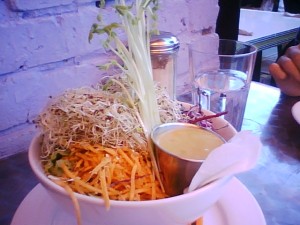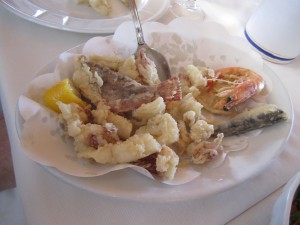If you know me, and we eat together at a restaurant more than once, we will probably go to
Aux Vivres (4631 St. Laurent Boulevard in Montreal) if I have my way. This is the sad truth for my friends (all three of them). As far as I am concerned, everything there is tasty and nothing hurts my stomach because there is no dairy to be found anywhere, and I am lactose- intolerant. The restaurant/cafe serves fresh and often organic foods and is a proudly vegan institution. The food is so delicious there is no need to apologize for its meatless-ness or mimic meat and dairy, but they do have a lot of foods that feature creams made from tofu or nuts, and tempeh bacon and tofu scrambles are popular items on their weekend brunch menu. My boyfriend and favourite dining companion, Henry, pictured below, always gets the BLT on chapatti bread, which is composed of lettuce, tomato and smoked coconut with a white spread that is reminiscent of good old mayonnaise.
The sandwich is smoky, salty deliciousness. Every week there are specials that showcase seasonal items, and recently they had a beet latke plate and sweet potato burritos.
I order the same thing every time I go to Aux Vivres, which is the Dragon Bowl. Just typing “the same thing every time” makes me feel a little, how do you say, boring. In my defense, I have ordered other dishes there, thoroughly enjoyed them, and then pined for the Dragon Bowl all the way home. It is a bowl of organic brown rice topped with piles of fresh vegetables: spiraled beets, shredded carrots, chopped lettuce, two kinds of sprouts, and daikon radish. This mound of goodness is sprinkled with gomashio (unhulled black and white sesame seeds and salt) and is served with Dragon Bowl sauce, which is liquid gold.
I eat the vegetables and rice in the Dragon Bowl because they are a vehicle for said sauce. You can purchase it bottled at Aux Vivres, but then you have to cut up all the vegetables and cook the rice and I figure I will never be able to do it as well as they do (I have yet to invest in a mandolin for that perfectly thin daikon slicing), so I am happy to pay about ten dollars to feel like someone is looking after me for an hour or so.
Recently, my friend Lorie pointed me to a recipe for Dragon Bowl sauce written by the talented jae steele, who used to make Aux Vivres’ desserts. Her sauce calls for:
1/4 cup nutritional yeast
3 tbsp grapeseed or olive oil
2 tbsp. maple syrup
2 tbsp. tamari soy sauce
2 tbsp. filtered water
1 large or 2 medium cloves garlic
Blend all ingredients with a hand blender, or in a blender or food processor. Makes enough sauce for 3 Dragon Bowls. Store any leftovers in a sealed glass jar in the fridge for up to 1 week.
This version is good, but not as good as the one I long for when it’s been a while since my last fix. Maybe that has something to do with the fact that I used regular soy sauce rather than tamari soy sauce, and my olive oil might be a little off. Next time I will follow the recipe and maybe add a bit less than 2 tbsp. filtered water. But try it! Or just go to Aux Vivres and have a Dragon Bowl. You won’t be sorry. At least, I never am.
Check out Marsha’s bio on the Contributors page.















